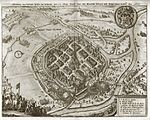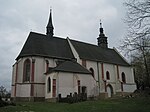Pilsner Urquell Brewery
Plzeňský Prazdroj, a. s. (pronounced [ˈpl̩zɛɲskiː ˈprazdroj a ˈɛs]), known in English as the Pilsner Urquell Brewery, is a Czech brewery opened in 1842 and headquartered in Plzeň, Czech Republic. It was the first brewery to produce pale lager, branded as Pilsner Urquell, which became so popular and was so much copied that more than two-thirds of the beer produced in the world today is pale lager, sometimes named pils, pilsner and pilsener after Pilsner Urquell. The brewery name, Pilsner Urquell, which can be roughly translated into English as "the original source at Pilsen", was adopted as a trademark in 1898. Pilsner Urquell is the largest producer and exporter of beer in the Czech Republic.The brewery was part of the SABMiller group of companies (at first South African Breweries) from 1999 to 2017. As part of the agreements made with regulators before Anheuser-Busch InBev was allowed to acquire SABMiller in October 2016, Pilsner Urquell (excluding certain geographical areas) was sold to Japan-based Asahi Breweries in March 2017.
Excerpt from the Wikipedia article Pilsner Urquell Brewery (License: CC BY-SA 3.0, Authors).Pilsner Urquell Brewery
U Prazdroje, Pilsen Plzeň
Geographical coordinates (GPS) Address Nearby Places Show on map
Geographical coordinates (GPS)
| Latitude | Longitude |
|---|---|
| N 49.746666666667 ° | E 13.387222222222 ° |
Address
U Prazdroje
U Prazdroje
304 97 Pilsen, Plzeň
Southwest, Czechia
Open on Google Maps











